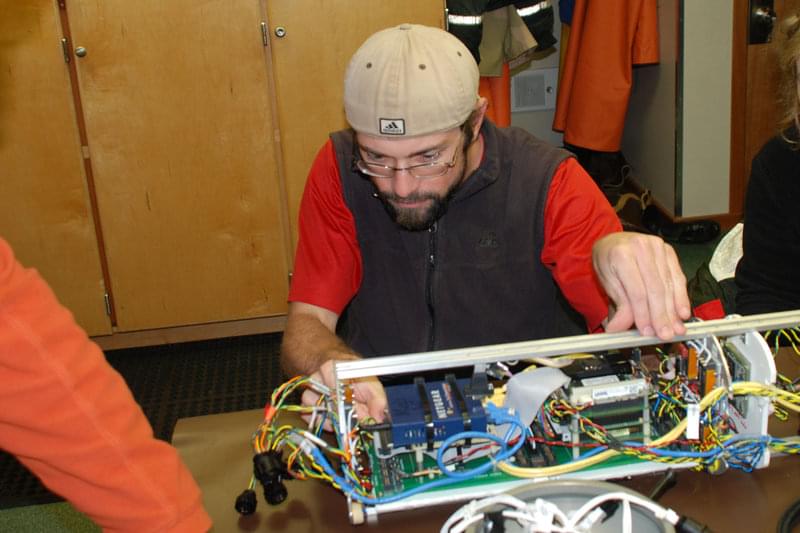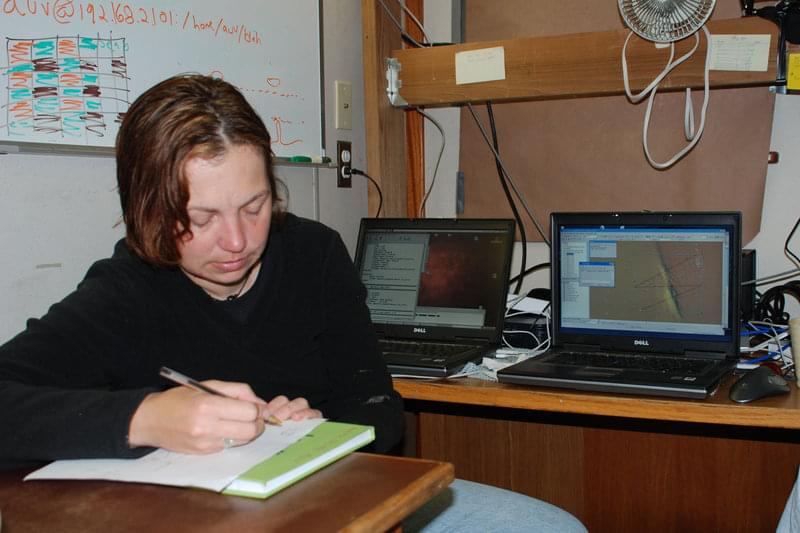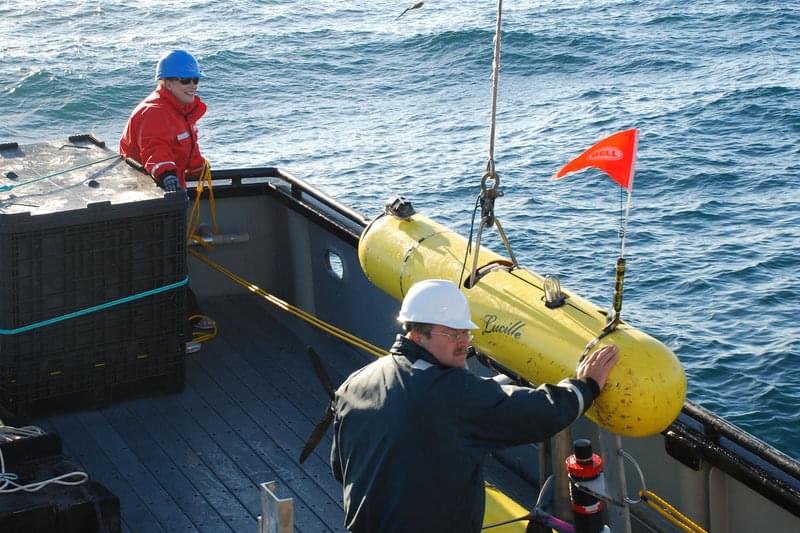
By M. Elizabeth Clarke - Research Fisheries Biologist - Northwest Fisheries Science Center,
Erica Fruh - Northwest Fisheries Science Center,
and Jeremy C. Taylor - U.S. GePacific Islands Fisheries Science Centerological Survey, Biological Resources Division
September 27, 2010
Even though the AUV is working autonomously, sometimes we want to communicate with it in order to follow its progress in accomplishing its dive plan and in some cases to ask to change its mission during a dive. One of the most important things we do before a dive is to make sure we have all the communications working before the AUV dives.

Prior to launch, Jeremy Taylor double checks the inner workings and wiring of the AUV to ensure clear communication between the vehicle and the surface during the dive. Image courtesy of San Andreas Fault 2010 Expedition, NOAA-OER. Download image (jpg, 131 KB).
The AUV uses X and Y coordinates to navigate in a pattern covering the areas of seafloor we want to photograph. The patterns can include zigzags, grids or straight lines (legs). The goal of the mission determines the pattern. The AUV can be programmed to cover a tight grid, and then the photos can be overlapped in later processing to produce a photo mosaic. The mission plan logDirects the AUV on its dive plan and is a text file that is loaded onto the vehicle. The AUV reads the first logDirection and off she goes.
The AUV is given a dive plan, and all systems are checked out before the vehicle is put in the water. At this point all hard lines of communication and power sources are un-tethered. While still at the surface, the AUV technician relies on a radio frequency (RF) modem to make last minute mission changes and start the dive. Before the final command to dive is given and the vehicle is in the water, we confirm that our two means of communicating with the AUV while it is under water are in working order. We use a USBL tracking system and an acoustic modem to monitor the AUV's progress during the dive.

Erica Fruh prepares the mission plan for a dive with the AUV Lucille. For this mission, Lucille was programmed to run a zigzag pattern over a section of the San Andreas Fault. Image courtesy of San Andreas Fault 2010 Expedition, NOAA-OER. Download image (jpg, 125 KB).
The AUV is given a dive plan, and all systems are checked out before the vehicle is put in the water. At this point all hard lines of communication and power sources are un-tethered. While still at the surface, the AUV technician relies on a radio frequency (RF) modem to make last minute mission changes and start the dive. Before the final command to dive is given and the vehicle is in the water, we confirm that our two means of communicating with the AUV while it is under water are in working order. We use a USBL tracking system and an acoustic modem to monitor the AUV's progress during the dive.

Out on deck, Russell Haner and Elizabeth Clarke make final preparations before deploying the AUV Lucille for a mission. Image courtesy of San Andreas Fault 2010 Expedition, NOAA-OER. Download image (jpg, 182 KB).
The USBL is an independent tracking system attached to the AUV that allows us to follow the vehicle’s position relative to the vessel. Approximately every minute or so it reports the vehicles range, heading and azimuth. We are able to plot the AUVs progress over the course of the dive in real time. This allows the tending vessel the ability to remain close enough for communication but far enough away to minimize any danger to the AUV if it were to ascend under the vessel.
The vehicle and the tending vessel are also equipped with acoustic modems for two-way communications. There are a pair of acoustics modems, one on the vehicle and one on the vessel. They query each other for information regarding the AUV's position, progress, goal ID, altitude, battery percentage and number of images taken. We are able to use this means of communication to send down any changes in position that we would like the vehicle to make. Being able to “drive” the vehicle becomes important to make adjustments to the dive plan, to protect the vehicle from other vessel traffic, or to recall the vehicle to the surface.
Both of the signals are monitored throughout the dive to keep an eye on the vehicle.